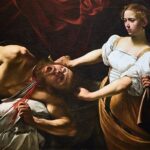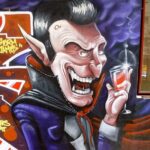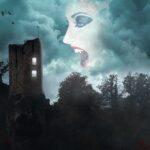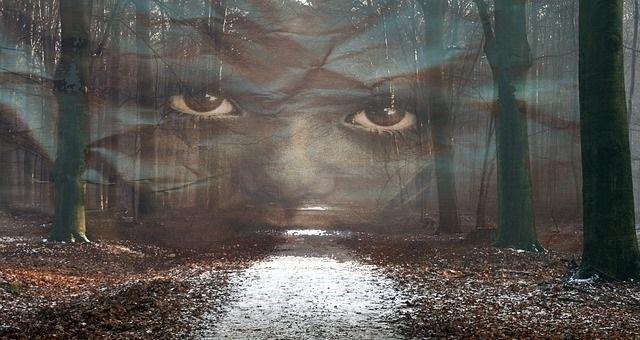
The 19th century produced some of the most notable horror novels in the history of the literary canon. Two such novels are Mary Shelley’s Frankenstein, first published in 1818, and Henry James’s The Turn of the Screw, published in 1898. The two novels vary in many aspects, perhaps most markedly in the subjective point of view of the “villain,” which is distinctly presented in Frankenstein while not at all in The Turn of the Screw; yet, in spite of all the differences, the novels do share noticeable stylistic resemblances. One of them is the motif of eyesight, which is associated especially with the texts’ heroes and villains.
This essay will show how the two novels use the motif of eyesight by their respective heroes and villains in a similar manner to reflect the characters’ subjective inner world through several selected passages from the texts.
The first time each of the novels’ villains engaged with eye-related act toward the protagonist – and toward the readers as well as first-person narratives build almost promptly empathy with the narrator – they produce a similar set of emotional reactions that revolve around horror. In Frankenstein, when Victor attempts to sleep after he created the monster, the monster approaches his bed, and his “eyes, if eyes they may be called, [are] fixed on” Victor; consequently, Victor terrifyingly “escape[s] and rushe[s] downstairs,” feeling agitated and fearful (chapter 5).
The governess in The Turn of the Screw renders a similar feeling of “shock” and “object of fear” when she first encounters whom she identifies later as the ghost of Peter Quint, who gazes at her intently from a tower while she walks with Flora (chapter III). The governess describes that she and Quint meet eyes with a “straight mutual stare,” then he changes his place while “looking at [her] hard all the while,” and finally, he walks away but remains “still markedly fixed” on the disconcerted governess. It is worth mentioning at this point a famous alternative Freudian theory by Edmund Wilson, who asserts that due to repressed sexual desires, the governess merely hallucinates the ghosts and, in this case, the tower she beholds holds a clear phallic implication (1999: 170-173).
Although the effects of the gazes on the novels’ narrating protagonists are quite similar, they also withhold different literary functions. The gaze of the monster in Frankenstein does not appear to be malevolent at all; in fact, the monster, with “a grin wrinkle[s] his cheeks,” would also likely arouse the readers’ compassion for a newborn creature, horrific as he may be, who simply tries to connect with his creator. In comparison, in The Turn of the Screw, the ghost of Peter Quint does clearly seem to stare at the governess and Flora with malice, which sets the initial atmosphere of horror and builds up the tension in the story. Besides the element of horror, these first frightful gazes of the villains in both novels are, therefore, actually also the introductory scenes to their characters and contain the basis from which the narrative is built upon and further developed.
Through the eyesight motif, the novels also emphasize the theme of the double, mirroring the villain and the hero in a very similar – and even practically identical – manner. In Frankenstein, while Victor works on creating a female companion to the monster and contemplates the dire outcome of such creation, he looks up and sees “by the light of the moon the daemon at the casement” from the other side of the window, a “ghastly grin wrinkle[s] [the monster’s] lips as he gaze[s] on” Victor (chapter 20). As Victor “look[s] on him,” he decides to break his promise and then tears “to pieces the thing” right in front of the monster’s eyes, who despairingly sees him “destroy the creature on whose future existence he depended for happiness.”
The researcher Rosemary Jackson theorizes that since the monster “is literally a product of scientist Frankenstein’s own ideas and actions,” the two share a “link between the self and its monstrous projections” and ergo “[t]he monster functions as a parodic mirror image of Frankenstein” (1986: 44); hence, when Frankenstein sees the monster on the other side of the window, it could symbolically be interpreted as if he actually looks at himself in the mirror with revulsion. In any case, the monster’s gaze from one side of the window leads Victor to act in a way that poignantly disheartens the monster, blurs the contrasts between the villain and the hero, and establishes the theme of the double.
Equivalently, the governess in The Turn of the Screw also finds herself in a similar situation in which the villain gazes at her chillingly from the other side of a window. The governess comes down the stairs on a Sunday and suddenly “become[s] aware of a person on the other side of the window and looking straight in”; she recognizes that menacing person as the same person who stared at her before from the tower, Peter Quint (chapter IV). Just as the stare of the monster affects Victor emotionally, Quint’s “deep and hard” stare propels the governess to take action as well: she attempts to confront Quint outside, but her “visitor had vanished.” The governess then places herself “where he had stood,” and at that moment, Mrs. Grose, who comes to the hall, sees her with the same shock as the governess saw her “own visitant” just moments before. This scene creates “a repetition of what had already occurred,” which both figuratively and literally signifies the mirroring of the governess and Quint.
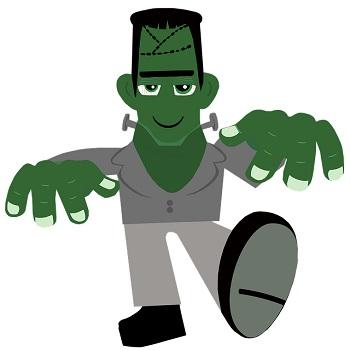
In both novels, therefore, the motif of eyesight is employed to catalyze the hero to a particular deed, which ultimately and somewhat ironically stresses the parallelisms between the hero and the villain.
The motif of eyesight also conveys and divulges the inner state of fear and paranoia of the two novels’ protagonists. However, whereas the paranoid disposition of the governess is predisposed toward herself and her close surroundings exclusively, Victor’s paranoia also sometimes tends to be more speciesist. When the governess watches Flora playing by the lake, she suddenly becomes aware of “an interested spectator” who “could sit – on the old stone bench which overlooked the pond,” although the governess is “without direct vision” of this alleged third-person (chapter VI); the governess does not actually see anybody, yet she defines this unseen apparition by its ability to watch Flora. The governess attempts to soothe herself rationally by reasoning that “the appearance of one of the men about the place” is natural, but it has “little effect … even without looking,” and then she describes how she suspiciously shifts her “eyes” back and forth from the spot of the invisible person to Flora and vice versa.
The next scene presents an even more suspicious mindset of the governess as she vehemently explains to Mrs. Grose how she “saw with [her] eyes” that “Flora saw” (italics in original) the female apparition, yet Flora would surely lie about seeing this apparition because she “doesn’t want [the governess] to know” (chapter VII). The profusion of words and terms relating to the motif of eyesight in these passages projects the growing paranoid mindset of the governess toward the children and her surroundings. As the governess who expresses her individual paranoia with the motif of eyesight, at times Victor imparts his suspicions and fears of the monster similarly. When Victor travels to Montanvert, he notices the monster following him and describes his shape as “sight tremendous and abhorred” and his ugliness as “almost too horrible for human eyes”; when they shortly thereafter talk, Victor curses the day “in which [the monster] first saw light” and asks to be relieved “from the sight of [his] detested form” (chapter 10).
The American critic and English professor, Maureen Noelle McLane, speculates that Victor may “suffer from reproductive paranoia” due to an “apocalyptic threat” (1996: 978) that the monster constitutes to the entire human species; indeed, there are strong indications for such theory. After Victor sees for the first time his creation, he dreams that his future wife and hope for posterity, Elizabeth, is dead (chapter 5); after Victor recognizes the monster in the woods whilst “gazing intently,” he determines that “[n]othing in human shape could have destroyed the fair child” – his younger brother who could also symbolically stand for posterity (chapter 7); and finally, right before Victor sees the monster at the window and destroys his female creation, he explicitly remarks to himself that “a race of devils” would “make the very existence of the species of man a condition precarious and full of terror” (chapter 20). The motif of eyesight is therefore coupled with the protagonists’ deep anxieties, distrust and paranoia throughout the novels and helps to express their suspicions and fears.
As stated at the beginning, only in Frankenstein the villain gets to retell the story from his own subjective point of view, and a significant part of his narrated account is linked profoundly with the motif of eyesight. The monster tells Victor about his dismal experiences with people who see him and how because of the effect of his sight, he determined to remain secluded and unseen in a hovel adjoining a cottage that he discovered (chapter 11). In the hovel, by “looking through a small chink” (chapter 11), he attentively observes a family from which he learns basic civilized behavior, including speaking and reading (chapters 11-15), which demonstrates his keen eagerness and curiosity to learn. When he finally approaches De Lacey, the old blind man who cannot see him, he manages to conduct a relatively pleasant conversation with him; but as soon as the rest of the family members arrive and do see him, they exhibit “horror and consternation on beholding” the monster (chapter 15). Thus, the motif of eyesight is integrated deeply within the monster’s narrative and assists in reflecting his subjective emotions and feelings from his own point of view.
While in The Turn of the Screw, there is no evident subjective account of the villains’ side, a reading based on the aforementioned Edmund Wilson’s theory divulges that the governess’ visions are “primarily and completely a characterization of” her own self; hence, the villainous apparitions that the governess sees – or imagines that she sees – is the sole reflection of her own inner “morbid psychology” (1999: 172). The motif of eyesight in the monster’s narrative in Frankenstein carries consequential meanings for understanding his character, feelings and perhaps even actions; in The Turn of the Screw, however, only a certain type of psychological interpretation of the novel enables one to see the villain’s point of view, who is actually the governess whose visions are a disturbing figment of her imagination.
The 19th-century novels Frankenstein and The Turn of the Screw wield the same literary device – the motif of eyesight – in a very analogous style. By dramatizing acts of horror and relaying descriptions of horror whilst relating them to eyesight, both Shelley and James artfully shed light on the emotional, mental and psychological state of the characters. Through the varied utilizations of the motif of eyesight, the characters evoke feelings from each other and the readers, the borderline between a villain and a hero is eroded, and different subjective realities are narrated and consequently interpreted. All of these add to the narratives additional layers of meanings and understanding that substantially enrich the novels’ hermeneutics and improve the satisfaction and edification of the ultimate reading experience.
Works Cited:
Jackson, Rosemary. 1986 “Narcissism and Beyond: A Psychoanalytic Reading of Frankenstein and Fantasies of the Double.” Aspects of Fantasy: Selected Essays from the Second International Conference on the Fantastic in Literature and Film. Westport, Conn.: Greenwood Press.
James, Henry, and Georgina Wilson. 1965. The Turn of the Screw. Popular Library.
McLane, Maureen N. “Literate Species: Populations, “Humanities,” and Frankenstein.” ELH 63.4, pp. 959-988.
Shelley, Mary Wollstonecraft. 2008. Frankenstein, Or, The Modern Prometheus 1818. Engage Books.
Wilson, Edmund. 1999. “The Ambiguity of Henry James.” The Turn of the Screw. Eds. Debora Esch and Jonathan Warren. New York, London: Norton & Company.
